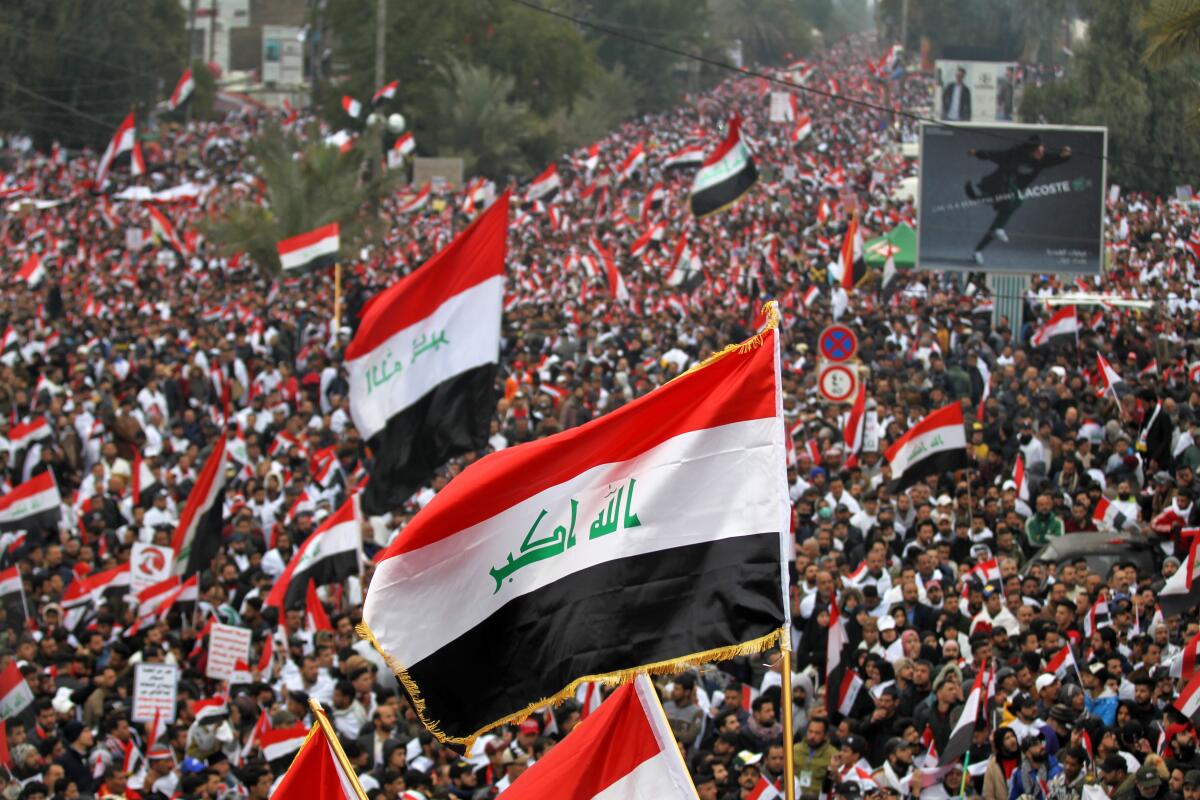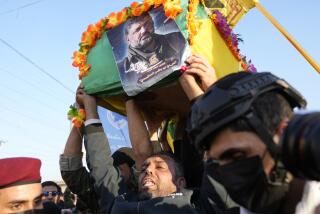Thousands rally in Baghdad to demand U.S. troops leave Iraq

- Share via
BAGHDAD — Muqtada Sadr, one of Iraq’s most inscrutable leaders, has portrayed himself as a reformist cleric, harboring criticism not only for the U.S., but also for Iran over its interference in Iraq’s affairs.
On Friday, he displayed that stance again, rallying tens of thousands to demand the U.S. leave Iraq, even as he pushed to limit the power of the Iran-backed Iraqi factions that were his ostensible partners in the protests.
Massive crowds heeded his call, many of them waving Iraq’s black, red and white colors as they marched through the capital’s Jadriyah district.
“The Americans have left nothing working in Iraq. They destroyed it and then stole everything,” said one man standing in the crowd.
Along the protesters’ path, a large stage had been prepared for speakers. Below the lectern, a banner attached to the front of the stage read “GET OUT AMERICA.”
Pro-Iran channels also broadcast images of a gallows, with a puppet in the image of President Trump swinging from a rope alongside three others dressed in U.S. Army gear.
Sadr’s rally followed weeks of escalating confrontations between the U.S. and factions linked to the Population Mobilization Forces, an umbrella group which includes militias formed in 2014 to defend against Islamic State; it has since become an official arm of Iraq’s security services, but is viewed by many as having deeper loyalty to Tehran than Baghdad.
Tensions rose further after the assassination of Iran’s Maj. Gen. Qassem Suleimani on Jan. 3 in a U.S. drone strike. The attack also killed Abu Mahdi Muhandis, an Iraqi leader who was the driving force behind the Popular Mobilization Forces.
In its aftermath, Shiite parliamentarians, including Iraq’s caretaker prime minister, Adel Abdul Mahdi, passed a resolution that called for an immediate pullout of foreign forces in the country. The U.S. has approximately 5,000 soldiers and an unspecified number of contractors stationed in bases across Iraq, working alongside Iraqi forces on anti-Islamic State missions as well as train-and-assist operations.
In response, Trump threatened to impose sanctions while members of his administration hinted at other punitive measures if the U.S. was forced to withdraw. Meanwhile, the paramilitary factions demanded revenge.
Still, in a statement on Friday, Sadr insisted he would expend all efforts not to drag the country into war with the “sinful invader.” Instead, he counseled, peaceful methods would be used to get a “timetable for the exit of the forces of invasion.”
That exit, he continued, would involve closure of all U.S. bases and American security firms in Iraq, as well as the cancellation of security deals.
Though the focus was on the U.S., Sadr’s statement also spoke of measures to curb Iranian influence. He called for the merger of the Popular Mobilization Forces into the ministries of defense and the interior, and to punish any group that breaks what he described as a “truce of sovereignty.”
The militias are often accused of conducting rocket attacks on U.S. bases as well as the U.S. Embassy in Baghdad. The Iranian ballistic missile attack on Jan. 8 left 34 U.S. troops with concussions or traumatic brain injury, the Pentagon said on Friday; a number of contractors were also sent back to the U.S. for treatment.
The Popular Mobilization Forces had also promised their own response, with some issuing threats against both the U.S. Embassy and anti-government protesters bunkered for months in Baghdad’s central Tahrir Square and other cities across Iraq’s south.
Those demonstrations have seen thousands calling for a full repudiation of the country’s political class in the midst of pitched battles with security services that have left some 600 people dead and thousands wounded.
The contrast between the two movements — one a revolution fought by the state with lethal force, the other virtually state-sanctioned — belied a shared element in their message: that all foreign influence in the country should end.
Though Friday’s protest was orchestrated, it’s hard to argue that many Iraqis don’t have genuine grievances against America.
Iran may have been the big winner in the U.S. invasion in 2003, but it was the U.S. that installed leaders amenable to Tehran. And corruption wasn’t directly all America’s the U.S.’ fault, but its actions enabled a cadre of corrupt politicians to take over the country.
Sadr remained true to his word, and a feared attack on the U.S. Embassy didn’t materialize. But the protests did resonate with Iraqis beyond his supporters.
Iraqi President Barham Salih posted a picture of the demonstrations. Under it he wrote, “Iraqis insist on a state with full, unviolated sovereignty, serving its people and expressing their independent national will, far from interventions and dictate from abroad.
“A state that guarantees their security and rights in a free, dignified life, a state in security and peace with its neighbors.”
More to Read
Sign up for Essential California
The most important California stories and recommendations in your inbox every morning.
You may occasionally receive promotional content from the Los Angeles Times.














